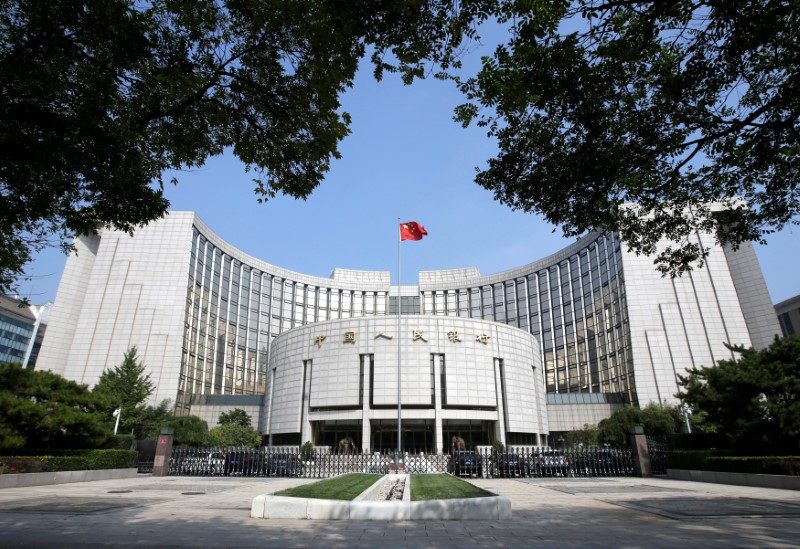China’s bond market rattled as central bank squares off with bond bulls

SHANGHAI/HONG KONG (Reuters) – China’s bond market, the world’s second largest, is on edge following a turbulent week in which the central bank started intervening heavily to stem a plunge in yields even as the economy is struggling.
But die-hard investors say the bull market in government bonds still has legs, citing China’s wobbly economy, deflationary pressures and low investor appetite for riskier assets.
“We remain actively bullish,” said a bond fund manager, undeterred by unprecedented government moves to cool the sizzling treasury market and arrest a plunge in yields, which move inversely to prices.
“We don’t see a rosy economic picture … and we’re under peer pressure to generate returns,” said the Beijing-based manager who asked to be anonymous due to sensitivity of the topic.
Even those who have turned bearish appear half-hearted. Treasury futures investor Wang Hongfei said he chose to be “opportunistic” in the short term, trading quickly in skirmishes as the market tussle with regulators intensifies.
China’s central bank has repeatedly warned of potentially destabilising bubble risks as investors chase government bonds and scurry away from volatile stocks and a sinking property market, while banks cut deposit rates. Falling yields also complicate the People’s Bank of China’s (PBOC) efforts to stabilise the weakening yuan.
But with the PBOC now turning threats into action to tame bond bulls, authorities have opened a new battle front – following wars of attrition long fought against speculators and unwelcome price moves in the country’s stock and currency markets.
Unlike the West, “China’s financial markets, including the bond market, are subject to top-down regulation,” said Ryan Yonk, economist with the American Institute for Economic Research.
As the economy sputters, “Chinese officials will face increasing difficulty in maintaining such tightly controlled financial markets, and additional interventions are likely, and may signal the very instability Chinese officials are seeking to avoid.”
FIRST SHOT
The first shot was fired last Monday, when China’s long-dated yields hit record lows amid a global rout that drove money into safe havens such as treasuries.
State banks were seen selling large amounts of 10-year and 30-year treasuries after treasury futures jumped to record highs.
Debt dumping by state banks – confirmed by data and traders – continued throughout the week, mirroring how the central bank uses big banks as agents at times to influence the yuan currency market, traders said.
Late on Friday, the central bank said it will gradually increase the purchase and sale of treasury bonds in its open market operations.
PBOC Governor Pan Gongsheng was previously head of China’s foreign currency regulator, so “it appears to be the same playbook,” said a Shanghai-based fund manager.
In another warning shot to bond buyers, the PBOC ceased providing cash through open market operations on Wednesday for the first time since 2020, contributing to the biggest weekly cash withdrawal in four months in support of yields.
Dealing a further blow to market sentiment, China’s interbank watchdog said it would investigate four rural commercial banks for suspected bond market manipulation, and would report several misbehaving financial institutions to the PBOC for penalty.
The PBOC did not reply to a Reuters request for comment.
‘SWORD OF DAMOCLES’
To be sure, the flurry of measures have made some investors cautious. Both China’s 10-year and 30-year treasury futures posted their first weekly fall in a month.
“Taking all factors into account, it would be prudent to exercise additional caution regarding China duration risk,” Kiyong Seong, lead Asia macro strategist at Societe Generale (OTC:) said, referring to the risk of holding long-dated bonds.
“While the scale of any selloff in China bonds may not be substantial in the medium and long term due to the fragile growth momentum in China, chasing duration returns in China does not seem appropriate in our view.”
Tan Yiming, analyst at Minsheng Securities, wrote in a note: “The sword of Damocles is falling.”
But in a so-called “asset famine” environment where high-yielding assets are in short supply, “the bond bull remains alive,” Tan said.
The Shanghai-based fund manager said there’s no reason to throw in the towel without seeing clear signs of economic improvement, and his strategy is to “buy on the dip”.
“You cannot change market direction using technical tools, just as you cannot change the temperature by adjusting the thermometer,” he said.
The PBOC moves could change the tempo of bond price rises, but not the uptrend, he said. “If you hold long enough, you will make money.”
However, rising volatility shows the central bank is at least making some progress in giving investors pause for thought.
Chun Lai Wu, head of Asia Asset Allocation at UBS Global Wealth Management, cautioned that expected support to Chinese bonds from any monetary easing will likely be offset somewhat by stepped-up government bond issuance.
China’s 30-year treasury yield is currently around 2.37%, compared with 3% a year ago.

“Over the long term, we could see the … yield drift higher, maybe towards 2.5%, if indeed we see the economic recovery continue and inflation begin to return.”
($1 = 7.1715 renminbi)





